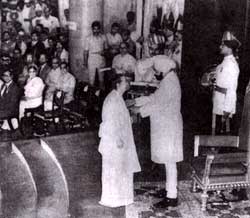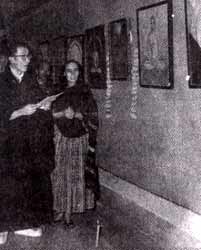


REMEMBERING THE BRUNNERS
BY PROF. P.N. MAGO
Elizabeth Brunner had been described by Dr. Lokesh Chandra as ‘a living symbol of vision that awakened a new mind, to which the world is an heir today.’ By gloriously painting the political pantheon of Inda, including Mahatma Gandhi, Pandit Nehru, Govind Vallabh Pant and Padmaja Naidu, she has left for future generations a record of heroism of the highest order. In 1985, her devotion to her work won her the Padma Shri.
This enlightened soul, described as India’s Hungarian daughter, passed away on May 2, in New Delhi after long years of illness, She was 91.
Born on July 1, 1909, in the small town of Nagykaniza in Hungary, Elizabeth was the child of Forenc Sass and Elizabeth-both painter. The depression after World War I split the family. Her father, disillusioned with the tragedy of the war, went into seclusion. Elizabeth Sass Brunner, with her daughter Elizabeth, moved to Budapest. She surrendered to the will of God and actively pursued her painting.
According to Elizabeth Brunner, who was then a student of sculpture at the Hungarian Academy of Art, her apparition told her that whatever she could achieve had already been achieved by her, but what she was looking for could be found only in India; that she had spiritual qualities and if she wanted to evolve, she must go to India and be the apparition’s guest. Her decision was made.
Elizabeth Sass Brunner’s dream of visiting India, inspired by an inner impulse, came true and she, with her daughter Elizabeth, arrived in Santiniketan in February 1930, at the invitation of Rabindranath Tagore. Later, in Santiniketan, Sass Brunner saw a photograph of Rabindranath Tagore’s father, Maharishi Devendranath Tagore it resembled the apparition she had seen.
For the mother and daughter (then 19), the journey to India was remarkable, from a homeland to a homeland-to-be, full of feeling, emotion and courage. For, they ultimately decided to stay on in India. Elizabeth Sass Brunner died in 1950 and Elizabeth, the daughter, continued to live in India till the will of God made her depart from us recently.
After a period of social work in the 60s and 70s, Elizabeth Brunner settled to work in New Delhi. She practically discontinued painting after 1972 due to ill health. For half a century, she sustained herself with the warmth of affection of her friends and well wishers. She had developed great spiritual strength.
James Redfield and Carol Adrienne, in their remarkable book ‘The Celestine Prophecy – An Experimental Guide’ (Bentarn Books), refer to a belief in India that if there is one holy person in a village, the whole village reaps the benefit of his or her enlightenment – and quote Dr. Patrick Triffle on Albany, California, on how he observed the effect of one person’s energy on others.
“I was lucky enough to meet painter Elizabeth Brunner, who had been friends with several world leaders such as Gandhi and Nehru. I went to her house when she was in her eighties and was amazed to see that she had an aura that extended about four hundred feet beyond her physical body. I watched visitors come to her, and just by being in her presence, they became immediately loving and kind, even if they were greedy types. Such was her dedication to God.”
Indian art lovers are familiar with works of the Brunners-these have been displayed frequently in India. Their works have also been exhibited in Japan, USA, Britain, Myanmar, Sri Lanka, Thailand and of course, Hungary. The IGNCA had, just last year, sponsored a retrospective exhibition ‘Dreams and Visions Search for the Spiritual’ as a tribute to Elizabeth Sass Brunner and Elizabeth Brunner. Curated by me, the exhibition was an eye-opener for artists and connoisseurs to the Brunners’ life and dedicated search for the spiritual through art.
The Brunners were deeply impressed by Gurudev Rabindranath Tagore. They meditated in Santiniketan and visited all the holy places – from Bengal to Gujarat and the Himalayas to Rameshwaram. They were completely transformed when they encountered great personalities like Mahatma Gandhi, Vinoba Bhave and Pandit Nehru.
They were charmed by India, its people and their way of life, the landscape and its leaders. For, they came to India in an era when great people lived and worked for freedom and promoted love and peace among mankind. The two established a certain affinity with the land, its people and philosophical thought.
Their creations may, in a certain sense, be copies of the external world but they are rich with contributions of the mind and full of emotions and suggestions. When representing philosophic and spiritual ideas, Sass Brunner reveals that the aim of the artist was not so much imitation of the original as imitation of the mental image of that form, as grasped by emotion and brought in touch with the very life and soul and the artist. In her paintings of Nature, whether done in Hungary, Italy or India, the emotive movement of a trance-image she sought to represent was a moment snapped out of the rhythmic flow of creative joy that formed the essence of the artistic impulse. Even in her small formats, she laid more emphasis on the delineation of the spiritual essence, the idealized intrinsic vision, the mental creation, than on copying the physical features exactly as they appeared to the eye. Her goal seems to have been the conscious discipline of the self which provides a unique flavour to her landscapes, the forms of trees, dramatically clouded skies and reflections in water, lakes and dashing sea waves.
In her other range, consisting of spiritual subjects like Christ, Buddha, symbols of Shiva, the religio-mystic themes are treated conceptually, each having its own message. They possess a subtle power of expression and touch the mind. She has used the appropriate technique and skill to filter the fluid images of the subconscious for a clear presentation.
While the mystic canvases and landscapes of Elizabeth Sass Brunner are fantasies of her Indian experience reflecting, as it were, the poetic image of her own sensitive being. Elizabeth Brunner’s interest varied from portraits to images of the Buddha. Though she followed her mother’s work and spiritual inclination with loyalty, the focus of her artistic interest was the human being. She was able to understand the deepest essence of a person and capture it on canvas. This is amply evident in conceptual portraits of Rabindranath Tagore, Mahatma Gandhi and dramatic portraits of ethnic types and friends.
Her style, derived from the European realist tradition, is enlivened by a semi-impressionist handling, colours high in tone, and a rather un-impressionistic solidity of drawing. Modeling and finish are rendered in impeccable decorative lines. The portraits are competently executed, with special attention paid to the eyes, which reveal the character of the sitter.
The portraits have been so painted that the suggestion of plastic forms and the play of colours make our mind leave the objective reality and merge with the artist’s mind. We seem to share the artist’s experience and the joy, which created the work.
Elizabeth Brunner’s paintings, including a limited number of landscapes, express the fragrance of her mind, her contemplation and intuition. Her painting of Buddha reveal her understanding of the quietude and wisdom of Buddhist philosophy and love for mankind.
Both mother and daughter synthesize and summarize their descriptive to build an illusion, each in a highly personal style. They were, however, far removed from any stylistic domination of the Modern Art movement in Europe, or any local style in vogue in their days, such as the Bengal School. Their works are essentially descriptive in style and emphasized structural quality in their images at times dreamy and fantastic, rendering objects and nature in a dramatic play of colour, light and dark. Some of their works possess a quaint, ethereal iridescence in patterns of light and colour, particularly those of Sass Brunner. Both of them remained without fetish of any kind, occidental or oriental. For, their art was intensely subjective, guided by a deliberate intellect and surcharged with a strong emotional impulse.
To quote Jaya Appasamy, “Perhaps among the travelers who were drawn to the East, they were among the few who approached the problems of India with deep sympathy and sensitivity. They loved the country in a different way and identified themselves with Indian national aspirations and Indian philosophies. Though they had no direct part in political or social change, they left a prolific record of the Indian they knew.”
The deep impression of India and its religious philosophies is amply reflected in the works of both Elizabeth Sass Brunner and Elizabeth Brunner. Their works are tinged with a sense of humanism and spirituality. Their works are not to be viewed only on the basis of stylistic innovations, technical virtuosity or formal qualities. They should be viewed for their deeply sincere appreciation of the mystical beauty to which the Brunners had been awakened during their long years of stay in India.
The Brunners will always be remembered for their love for India and dedication to its philosophical ideas.
(Prof. P.N. Mago is an eminent artist art educationist and art critic. He curated an exhibition of Paintings by the Brunners in July, August last year.)
[ Newsletter | List of Newsletter ]




